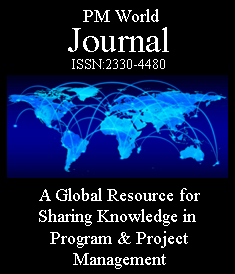A Practitioner-Adaptable Theoretical Model
Demonstrated on a Synthetic Case
PEER REVIEWED PAPER
By João Henrique Pettená do Carmo
Electrical Engineer, University of São Paulo (USP)
LL.B., Salesian University Center of São Paulo (UNISAL)
MBA in Project Management, University of São Paulo (USP)
São Paulo, Brazil
Abstract
Electric substation projects frequently encounter schedule slippage driven by design nonconformities, supply chain setbacks, and environmental licensing uncertainty. We develop and evaluate a compact Bayesian Network that quantifies schedule-delay risk pathways from those drivers using a fictitious, yet plausible synthetic dataset created for clarity, replication, and teaching. The five-node model—Team Experience, Project Conformity, Supply Delay, Licensing Issue, and Schedule Delay—uses expert-elicited conditional probabilities under monotonic causal assumptions. We report a theoretical baseline delay probability of ≈ 0.372, decompose contributions by parent configurations, and examine mitigation portfolios (independent design review, supply expediting, licensing task force), yielding single-lever reductions of 3.9–6.2 percentage points and ≈ 15.7 points combined in the synthetic population. Crucially, the workflow is designed for practitioner adaptation: we provide a ready-to-use prompt enabling managers to ingest their own historical spreadsheets to estimate parameters, run scenarios, and prioritize actions—without coding. All values are synthetic; no confidential data are used.
Keywords: Bayesian networks; schedule-delay risk; delivery risk; project management; electric substations; causal inference; decision support; artificial intelligence.
- Introduction
Substations intertwine civil works, high-voltage apparatus, protection and control systems, and multi-agency approvals. Two symptoms dominate managers’ attention: schedule delays and rework from design nonconformities. Traditional critical-path schedules and checklists remain indispensable, yet they struggle with interdependencies and partial evidence that emerge during procurement, licensing, and commissioning (PMI, 2021). Bayesian Networks (BNs) address this gap by: (i) encoding causal structure; (ii) allowing probabilistic inference with missing data; and (iii) supporting what-if reasoning and mitigation planning (Pearl, 1988; Jensen and Nielsen, 2007; Koller and Friedman, 2009).
This paper makes three contributions. First, we specify a parsimonious BN tailored to substation schedule-delay risk, grounded in causal intuition engineers recognize. Second, we construct a synthetic dataset and use it to illustrate baseline risk, sensitivity to priors, and mitigation effects, with results presented in reusable tables. Third, we provide a practitioner-ready prompt that ingests a manager’s historical spreadsheet to estimate BN parameters with simple regularization and monotonicity checks, enabling immediate adoption without coding. Throughout, we emphasize interpretability and auditability, aligning with good governance and lessons from reliability engineering (Billinton and Allan, 1996) and decision analysis (Fenton and Neil, 2019).
Positioning in recent literature. Since 2020, applications of AI/ML and causal models in project management have expanded markedly, with systematic reviews and empirical studies highlighting opportunities and pitfalls for prediction, decision support, and governance (Nenni et al., 2024; Adamantiadou et al., 2025; Felicetti et al., 2024; Salimimoghadam et al., 2025; Datta et al., 2024; Prasetyo et al., 2024). Within construction and infrastructure, BNs and dynamic BNs have been applied to schedule risk, multi‑hazard interactions, and reliability‑driven planning (Zhong and Zhang, 2025; Chen et al., 2023; Rezakhani, 2022; Arabi et al., 2022; Bakhtiari et al., 2025; Machado et al., 2023). In parallel, LLM‑based assistants and cognitive agents are being piloted to operationalize workflows for non‑programmers, echoing our practitioner prompt (Alliata et al., 2025; Cinkusz et al., 2025; Couder, 2024). We situate our theoretical construct against this body of work while focusing on an auditable BN that is readily adapted by practitioners to their own datasets.
- Research Questions
RQ1. Can a five-variable BN provide interpretable and actionable estimates of schedule-delay risk for substation projects?
RQ2. Among design review, supply expediting, and licensing acceleration, which lever reduces population-level delay prevalence the most?
RQ3. How sensitive is the baseline delay probability to plausible changes in supply and licensing priors?
RQ4. Can natural-language workflows operationalize BN estimation and scenario analysis for nonprogrammers?
More…
To read entire paper, click here
How to cite this paper: Carmo, João H.P. do (2025). Bayesian Networks for Substation Schedule-Delay Risk: A Practitioner-Adaptable Theoretical Model Demonstrated on a Synthetic Case, Vol. XIV, Issue X, October. Available online at https://pmworldlibrary.net/wp-content/uploads/2025/10/pmwj157-Oct2025-do-Carmo-Bayesian-Networks-for-Substation-Risk.pdf
About the Author

João Henrique Pettená do Carmo
São Paulo, Brazil
![]()
João Henrique Pettená do Carmo is a Project & Contract Manager with 19 years of experience in the energy sector and new product introduction (NPI). He holds a B.S. in Electrical Engineering (Electronics emphasis) from the University of São Paulo (USP) and an LL.B. (Bachelor in Laws) from the Salesian University Center of São Paulo (UNISAL), as well as an MBA in Project Management from USP, a Six Sigma Green Belt, and project management specializations from the University of Colorado System and the University of Leeds. He has worked on projects for companies such as AGCO, CPFL Soluções, General Electric, GLP Properties, Jacuzzi, Nissin Foods, and Zongshen Machinery.
Contact: pettena.joao at pm.me









